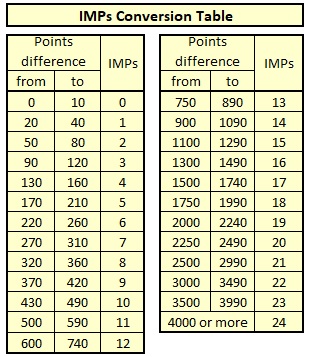 CROSS-IMPs SCORING
Duplicate bridge is great, but there are other ways of playing the game that can provide a different sort of challenge, and can be a lot of fun too.
In duplicate pairs, you are only really interested in getting a better score on the hand than other pairs playing the same hands. So, for example, the extra 10 points for 3NT+1 (430 or 630) is very important, if most other pairs play in 4S also making 10 tricks (420 or 620). Game in a minor tends not to score too well in duplicate. Crucial decisions about whether to sacrifice can hinge on one trick – if the opposition is making 2H for +110, then 2 down non-vulnerable is a great score, while 3 down is terrible. And every hand counts the same towards the result of the session, whether a slam hand or a lowly part-score. So if you bid and make a difficult slam and get a top, it can be wiped out by conceding one extra trick when the opposition play in a seemingly uninteresting 2 diamonds on the very next hand.
We do get used to trying to make these calculations, and it’s all part of duplicate pairs tactics.
Cross-IMPs scoring is a rather different game.
Where a board is played several times in a session, as is the case for a Cross-IMPs pairs session, the scores are converted to IMPs by comparison with a “datum”. In general, the process is:
1. Compare your score on each hand with others who played the same way
2. Calculate the difference between the scores obtained
3. Convert the difference into IMPs - using a standard score-to-IMP table.
4. Find the average of all these IMP scores
The key feature is that the number of IMPs awarded is based on the size of the score differences. This is significantly different from normal Duplicate Pairs Matchpoint scoring, where size of the differences in scores is irrelevant: all that matters is the order of the scores made by each pair. For example, if on a given board, all other pairs bid 2NT and make 9 tricks, but you bid 3NT and make the same 9 tricks, in Matchpoint scoring you simply get an outright top on that board. You would also get the same outright top for bidding 2NT and making 10 tricks. It makes no difference by how many points you beat the opposition scores, just that you get a better score than they do. If there are 24 boards in the session, that board will count for 1/24th of the session scores, as will every other board. If on another board, for example, you go crashing 4-off doubled vulnerable for -1100, the worst you can do is an outright bottom, a 0 on that one board.
But Cross-IMPs scoring works in a completely different way. Let's look at an example using Cross-IMPs scoring. Say a board has been played 10 times, and when you played it, you bid and made 6S vulnerable. Your score was +1430. Let's say no-one else has bid the slam- they were all in 4S making the same 12 tricks. They each scored +680. So your score is +750 compared with everyone else which converts to +13 on the IMP scale
What this means is that bidding and making games and slams is at a premium; going off for big penalties also has a large effect on the outcome of the session. Bidding on to grand slam, rather than settling for a small slam, pays big dividends if it makes. Overtricks are largely insignificant. One board can make a big difference to your score for the session, while lots of other boards might make little difference. So you can see the tactics of bidding and play need to be very different between Matchpoint and Cross-IMP scoring. Have a go, and enjoy!
|